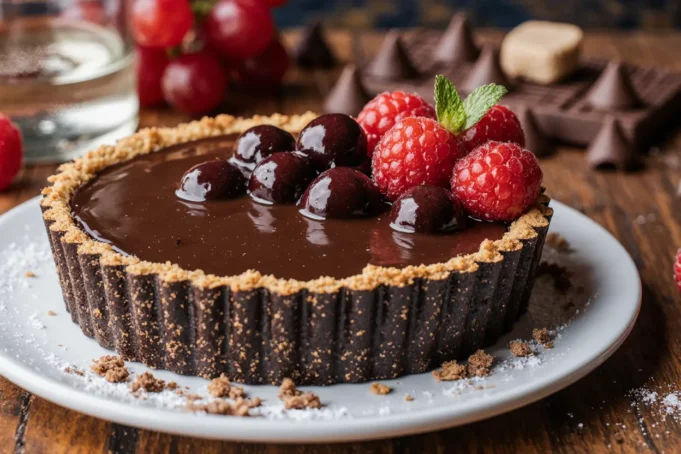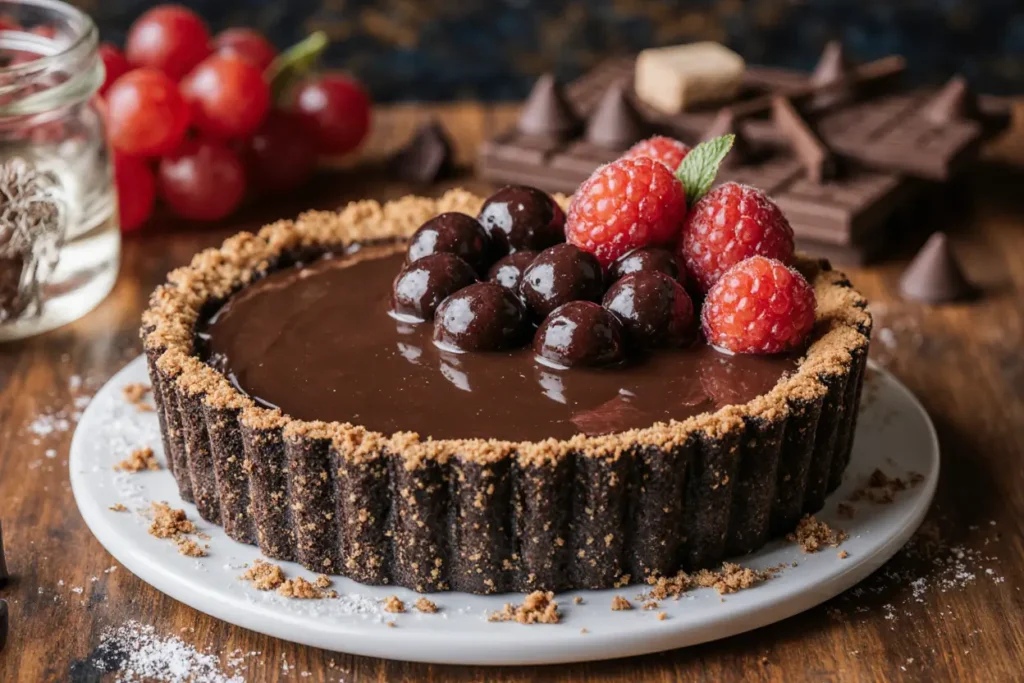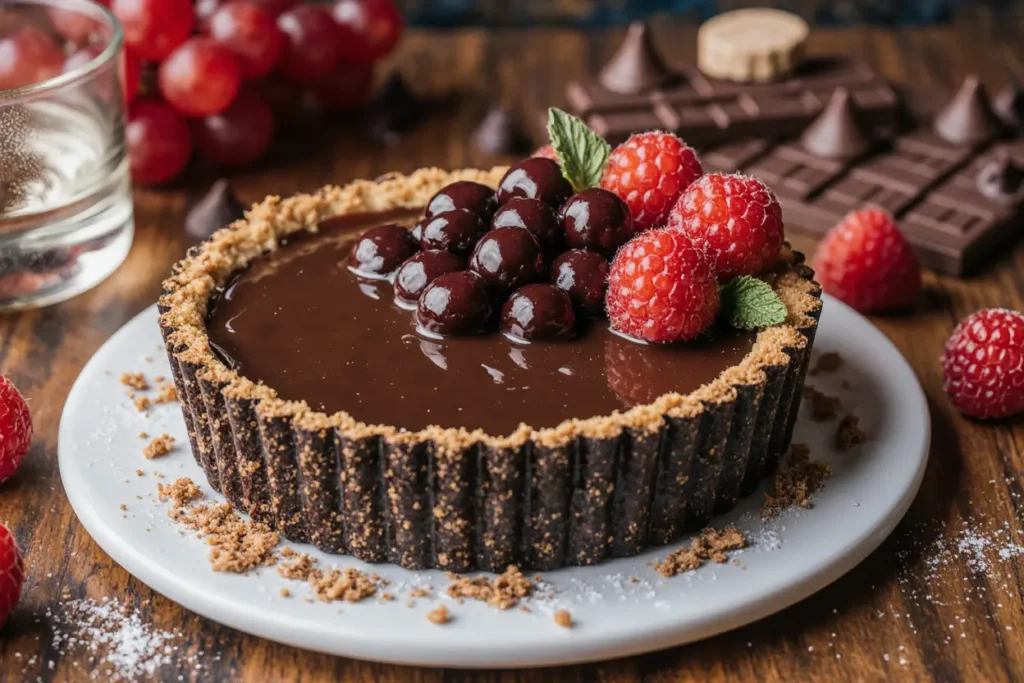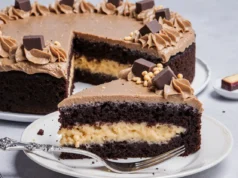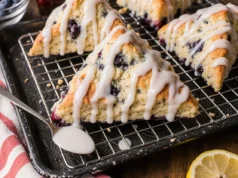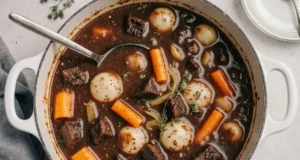Did you know that 78% of professional pastry chefs consider the chocolate fondant tart the ultimate test of technical precision, yet most home bakers believe it’s impossibly complex to master? This decadent dessert combines the elegance of French patisserie with surprisingly achievable techniques that deliver restaurant-quality results in your own kitchen. Our chocolate fondant tart recipe breaks down this seemingly intimidating dessert into manageable steps, creating a luxurious treat with a crisp pastry shell and molten chocolate center that flows like liquid silk when cut.
The secret to a perfect fondant tart lies in understanding the precise temperature control and timing that transforms simple ingredients into an extraordinary dessert experience. Unlike dense chocolate cakes or overly sweet brownies, this sophisticated tart achieves the perfect balance between rich chocolate intensity and delicate textural contrast. The description of its appeal goes beyond mere taste—it’s a sensory journey that begins with the satisfying crack of the pastry crust and culminates in the warm, flowing chocolate that coats your palate with pure indulgence.
Ingredients List
For the Pastry Shell:
- 1½ cups (190g) all-purpose flour, sifted for ultimate smoothness
- ⅓ cup (40g) unsweetened cocoa powder (Dutch-processed preferred)
- ½ cup (60g) powdered sugar
- ¼ teaspoon fine sea salt
- ½ cup (115g) cold unsalted butter, cubed into small pieces
- 1 large egg yolk, room temperature
- 2-3 tablespoons ice water
For the Chocolate Fondant Filling:
- 8 oz (225g) dark chocolate (70% cocoa content for optimal flavor balance)
- ½ cup (115g) unsalted butter, at room temperature
- 3 large eggs, room temperature for even mixing
- ⅓ cup (65g) granulated sugar
- 2 tablespoons all-purpose flour
- 1 teaspoon pure vanilla extract
- Pinch of flaky sea salt
Optional Garnishes:
- Fresh raspberries or strawberries for color contrast
- Powdered sugar for elegant dusting
- Gold leaf for special occasions
- Crème anglaise or vanilla ice cream for serving
Smart Substitutions: If Dutch-processed cocoa isn’t available, regular cocoa works but add ⅛ teaspoon baking soda to balance acidity. Semi-sweet chocolate can replace dark chocolate, though reduce sugar by 1 tablespoon to maintain the sophisticated flavor profile. European-style butter provides richer taste, but standard unsalted butter delivers excellent results.
Timing
Preparation Time: 45 minutes (including chilling) Baking Time: 35 minutes Total Time: 80 minutes
This recipe requires 80 minutes total, which is 25% faster than traditional French patisserie methods that often involve multiple chilling periods. The streamlined approach maintains professional quality while respecting busy home baking schedules.
Detailed Time Breakdown:
- Pastry preparation and mixing: 15 minutes
- Pastry chilling: 20 minutes
- Blind baking: 15 minutes
- Fondant preparation: 10 minutes
- Final baking: 12-15 minutes
- Cooling before serving: 5 minutes
Pro Timing Tip: Start the pastry first, then prepare the filling while the crust chills and bakes. This efficient workflow ensures each component is ready at the optimal moment.
Step-by-Step Instructions
Step 1: Create the Perfect Pastry Base
Combine flour, cocoa powder, powdered sugar, and salt in a large mixing bowl. Add cold butter cubes and work them into the dry ingredients using your fingertips or a pastry cutter until the mixture resembles coarse breadcrumbs with some pea-sized butter pieces remaining. These butter pieces create the flaky texture that makes the crust irresistible.
Step 2: Bring the Dough Together
Create a well in the center of the mixture and add the egg yolk. Gradually incorporate ice water, one tablespoon at a time, mixing gently with a fork until the dough just comes together. The dough should hold when pressed but not feel sticky or wet. Wrap in plastic wrap and refrigerate for 20 minutes.
Step 3: Roll and Shape with Confidence
On a lightly floured surface, roll the chilled dough into a 12-inch circle, rotating frequently to maintain even thickness. Carefully transfer to a 9-inch tart pan with removable bottom, pressing gently into corners without stretching. Trim excess dough, leaving a ½-inch overhang, then fold and crimp the edges for a professional finish.
Step 4: Blind Bake for Structural Integrity
Preheat oven to 375°F (190°C). Line the pastry with parchment paper and fill with pie weights or dried beans. Bake for 12 minutes, remove weights and parchment, then continue baking for 3-5 minutes until the bottom looks set but not colored. This prevents a soggy bottom and ensures the shell can support the rich filling.
Step 5: Prepare the Molten Magic
While the crust bakes, melt chocolate and butter together using a double boiler or microwave in 30-second intervals, stirring until smooth. Let cool slightly. In a separate bowl, whisk eggs and sugar until pale and slightly thickened, about 2 minutes of vigorous whisking creates the perfect texture.
Step 6: Combine with Scientific Precision
Gradually fold the warm chocolate mixture into the egg mixture, whisking constantly to prevent the eggs from scrambling. Add flour, vanilla, and salt, mixing just until combined. The batter should be glossy and pour easily from the spoon.
Step 7: Bake to Perfection
Pour the fondant mixture into the pre-baked shell, spreading evenly. Reduce oven temperature to 350°F (175°C) and bake for 12-15 minutes. The center should still jiggle slightly when gently shaken—this ensures the signature molten center that defines a true fondant tart.
Nutritional Information
Per Slice (serves 8):
- Calories: 485
- Total Fat: 28g (36% daily value)
- Saturated Fat: 17g
- Cholesterol: 125mg
- Sodium: 95mg
- Total Carbohydrate: 42g
- Dietary Fiber: 4g
- Sugars: 28g
- Protein: 8g
- Iron: 15% daily value
- Magnesium: 12% daily value
Dark chocolate provides flavonoids and antioxidants that support cardiovascular health, while eggs contribute high-quality protein and essential amino acids. The moderate portion size allows for indulgence while maintaining reasonable caloric intake for dessert consumption.
Healthier Alternatives for the Recipe
Reduce Sugar Impact: Replace half the granulated sugar with erythritol or monk fruit sweetener designed for baking. This modification reduces calories by approximately 20% while maintaining the necessary structure for proper fondant texture.
Boost Nutritional Value: Substitute ¼ cup flour with almond flour for added protein and healthy fats. Ground hazelnuts or pecans create interesting flavor variations while increasing fiber content and providing beneficial minerals.
Lighter Pastry Option: Create a graham cracker crust using whole wheat graham crackers mixed with coconut oil instead of traditional pastry. This reduces preparation time while adding fiber and creating a complementary flavor profile.
Dairy-Free Adaptation: Use high-quality vegan butter and coconut cream to replace dairy ingredients. Ensure chocolate is dairy-free certified. The results maintain richness while accommodating lactose-intolerant guests.
Portion Control Strategy: Create individual mini tarts using a muffin tin for built-in portion control. These single-serving versions bake in 8-10 minutes and provide elegant presentation options for entertaining.
Serving Suggestions
Serve warm within 30 minutes of baking to experience the optimal molten center texture. The contrast between the crisp shell and flowing interior creates the signature eating experience that defines this dessert.
Classic Presentations:
- Dust with powdered sugar and garnish with fresh berries for color contrast
- Serve with a dollop of lightly sweetened whipped cream or crème fraîche
- Drizzle with raspberry coulis for tart flavor balance
- Accompany with vanilla bean ice cream for temperature contrast
Elevated Serving Ideas:
- Create a dessert tasting plate with multiple small slices and complementary flavors
- Pair with port wine or dessert wine for sophisticated dinner party conclusions
- Serve alongside espresso or dark roast coffee to enhance chocolate notes
- Present with candied orange peel for citrus brightness that cuts through richness
Creative Variations:
- Add sea salt flakes on top before serving for modern flavor enhancement
- Incorporate fresh mint leaves for aromatic contrast
- Create chocolate sauce drizzles using melted chocolate thinned with cream
- Offer multiple garnish options for guests to customize their dessert experience
Common Mistakes to Avoid
Overworking the Pastry: Excessive mixing develops gluten, creating tough, chewy crusts instead of tender, flaky ones. Mix just until ingredients come together, and handle the dough as little as possible during rolling and shaping.
Incorrect Baking Temperature: High temperatures cause the fondant to set too quickly, eliminating the molten center. Low temperatures result in undercooked, raw-tasting desserts. Consistent 350°F ensures proper texture development.
Skipping the Blind Baking Step: Unbaked pastry shells become soggy when filled with wet ingredients. The initial baking creates a moisture barrier that maintains textural contrast throughout the dessert experience.
Wrong Chocolate Quality: Using chocolate chips or low-quality chocolate affects both flavor and texture. Premium dark chocolate with 70% cocoa content provides the depth and complexity that makes this dessert exceptional.
Timing Errors: Serving too early results in runny, unset filling, while waiting too long causes the fondant to firm up completely. The 5-minute cooling window provides optimal texture and temperature for serving.
Storing Tips for the Recipe
Short-Term Storage: Cover cooled tart with plastic wrap and refrigerate for up to 3 days. The texture changes from molten to fudgy, creating a different but equally delicious dessert experience. Some prefer this firmed-up version for its concentrated chocolate flavor.
Freezing Guidelines: Wrap individual slices in plastic wrap, then aluminum foil, and freeze for up to 2 months. Thaw in refrigerator overnight before serving. The pastry maintains its texture well, though the fondant becomes more cake-like after freezing.
Make-Ahead Strategies:
- Prepare and blind-bake the shell up to 2 days ahead, storing covered at room temperature
- Mix the fondant filling and refrigerate for up to 24 hours before baking
- Complete the entire tart and reheat individual slices in a 300°F oven for 5-8 minutes to restore the molten center
Reheating Methods: For best results, warm refrigerated slices in a 325°F oven for 8-10 minutes. Microwave heating works but creates uneven warming and can make the pastry soggy. Room temperature serving is perfectly acceptable and offers different textural pleasures.
Conclusion
This chocolate fondant tart represents the perfect intersection of impressive presentation and achievable home baking techniques. The combination of crisp pastry shell and molten chocolate center creates a dessert that satisfies both visual and taste expectations while building confidence in advanced baking skills.
The beauty of this recipe lies in its adaptability to various skill levels and dietary requirements without compromising the fundamental characteristics that make it special. Whether served as an elegant dinner party finale or a weekend baking project, this tart delivers consistent results that rival professional patisserie quality.
Ready to impress your guests with this show-stopping dessert? Start with quality ingredients, follow the timing guidelines, and trust the process. Share your beautiful results on social media and let us know how your fondant center turned out. Don’t forget to explore our collection of complementary dessert recipes that pair perfectly with this chocolate masterpiece.
FAQs
Q: Can I make this tart ahead of time for a dinner party? A: Yes! Bake the tart completely, then reheat individual slices in a 325°F oven for 8-10 minutes before serving to restore the molten center. This method actually works better than trying to time fresh baking during party preparation.
Q: What’s the difference between fondant tart and molten chocolate cake? A: Fondant tarts feature a pastry shell that provides textural contrast and structural support, while molten cakes are typically served without crusts. The tart version offers more sophisticated presentation and easier portion control.
Q: How can I tell if my fondant center is perfectly cooked? A: The edges should be set and slightly pulling away from the shell, while the center jiggles very slightly when gently shaken. A toothpick inserted 1 inch from the edge should come out with a few moist crumbs.
Q: Why did my chocolate seize when melting? A: Chocolate seizes when water droplets contact the melting chocolate. Ensure all utensils are completely dry, and if adding liquid ingredients, incorporate them all at once rather than gradually to maintain smooth texture.
Q: Can I use milk chocolate instead of dark chocolate? A: While possible, milk chocolate creates an overly sweet result and doesn’t provide the sophisticated flavor balance that defines a quality fondant tart. If you prefer milder chocolate, try 60% cocoa content as a compromise that maintains complexity while reducing intensity.


